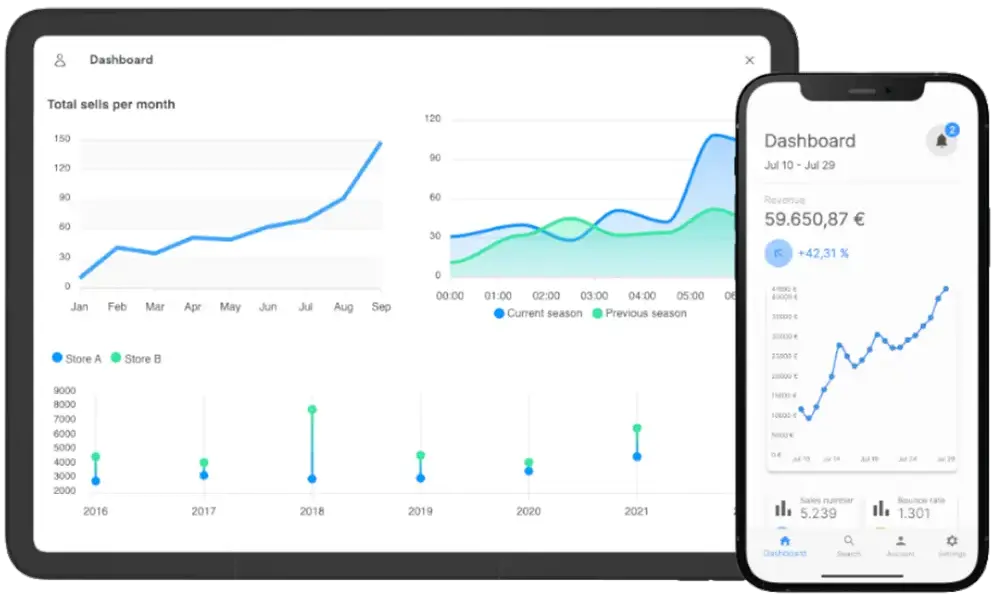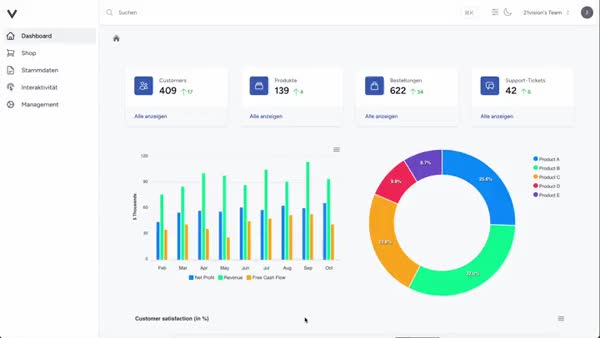Motivation
What are KPI Dashboard and how do we use them?
Key Performance Indicator (KPI) dashboards have emerged as indispensable tools for medium-sized businesses seeking to unlock their full potential in today's dynamic marketplace. It functions as a visual representation of essential metrics and performance indicators that offer real-time insights into various aspects of business performance.
These tools consolidate critical data from multiple sources, allowing businesses to monitor progress, identify trends, and make informed decisions.
The primary purpose of a KPI dashboard is to provide a holistic view of key business metrics, enabling stakeholders to assess performance against specific objectives and goals.
By condensing complex data into visually appealing and easy-to-understand formats, KPI dashboards empower business leaders to gain actionable insights at a glance. Gone are the days of sifting through spreadsheets and reports; with KPI dashboards, businesses can access the right information at the right time.
Example for KPIs in different industries
Logistics
For logistic companies the percentage of on-time delivery can be an effective way to measure the own performance.
Also, the delivery accuracy tracks the percentage of error-free deliveries. The inventory turnover measures the efficiency of logistics in managing inventory levels and optimizing cash flow by minimizing excess stock and avoiding stockouts.
Marketing
In marketing, three key KPIs are conversion rate, Customer Lifetime Value (CLV), and Return on Investment (ROI).
The conversion rate measures the percentage of visitors or leads that take desired actions. CLV tracks the total revenue generated by a customer throughout their relationship. ROI quantifies the financial return on marketing investments by comparing costs to revenue or profit.
Customer service
For the customer service sector, the average response time that an agent needs to respond to customer inquiries or requests is one of the most important statistics to measure performance.
Another important KPI is the Customer Satisfaction Score (CSAT) that typically provides insights into the overall customer experience through customer surveys or feedback.
The utilization of KPI dashboards goes beyond mere data visualization. These powerful tools enable businesses to track performance trends over time, set benchmarks, and compare actual results against targets. By focusing on key performance areas, such as sales, marketing, finance, customer satisfaction, and operational efficiency, KPI dashboards provide a comprehensive overview of business health and progress. This empowers decision-makers to identify strengths, uncover weaknesses, and prioritize areas for improvement.
Benefits
The Benefits of Using KPI Dashboards
By leveraging the benefits of KPI dashboards, businesses can gain a competitive edge, drive operational excellence, and achieve their strategic goals. There are a lot of advantages of KPI dashboards is medium-sized businesses, but we focus on the main three here:
- Increase Accountability and Transparency: KPI dashboards foster a culture of accountability and transparency within an organization. By providing employees with visibility into their individual and team performance metrics, dashboards create a sense of ownership and responsibility. Employees can track their progress, understand how their work contributes to overall goals, and take proactive steps to improve their performance. Furthermore, dashboards facilitate communication and collaboration by allowing stakeholders to access and share data easily. This transparency promotes alignment, collaboration, and a shared understanding of business objectives, leading to increased productivity and a more cohesive and empowered workforce.
- Enhance Performance Monitoring: With KPI dashboards, businesses can monitor their performance at a glance. These dashboards consolidate relevant information from various sources into a single, centralized platform, eliminating the need for manual data gathering and analysis. Real-time updates and visual representations of key metrics allow businesses to track progress towards goals, identify areas where targets are not being met, and take proactive measures to address any issues. By having a holistic view of performance, businesses can stay agile, identify bottlenecks, and take immediate action to optimize their operations for maximum efficiency and productivity.
- Improved Decision-Making: KPI dashboards provide businesses with real-time access to key metrics and performance indicators in a visually engaging and intuitive format. By having a clear and comprehensive overview of critical data, decision-makers can make informed choices quickly and effectively. Whether it's monitoring sales figures, tracking customer satisfaction, or assessing operational efficiency, KPI dashboards empower businesses to identify trends, patterns, and areas for improvement, enabling them to make data-driven decisions that drive growth and success.
Implementation
How to implement a KPI Dashboards
To kickstart the implementation of a KPI dashboard for your business, it's important to follow a systematic approach. Start by asking yourself what you want the dashboard to accomplish and what areas can are crucial to your success. Based on that, you can identifying the key metrics and performance indicators that align with your business goals. This step allows you to define the specific data points that need to be tracked and monitored.
Next, carefully consider your options when it comes to selecting a dashboarding tool or platform. While existing platforms may offer convenience, it's worth exploring whether a custom software solution would better align with your specific needs. Custom software provides unparalleled flexibility and can be tailored precisely to your requirements, ensuring a seamless integration with your existing systems and enabling you to unlock unique functionalities and insights.
On the other hand, existing visualization tools such as Microsoft Power BI and Tableau are more cost-efficient and can give a good starting point. However, it takes some time and effort to become proficient in using the tool effectively. Also, you will find out pretty quickly the limitations when it comes to customizing complex or highly specialized dashboards. The decision strongly depends on the importance you give the project.
Software agencies can help you by providing insights, guidance, and technical expertise in planning, implementing and maintaining KPI dashboards.

Once you have the web-based dashboard in place, consider the advantages of seamlessly integrating a mobile app that collects relevant data. This integration allows you to capture real-time information directly from the field, enabling you to monitor performance on the go. An enterprise mobile app can provide convenience, flexibility, and instant access to crucial insights for decision-making.
At 21vision, we understand the importance of a well-implemented KPI dashboard and the potential benefits of a mobile app integration. Our experienced team can guide you through the entire process, from selecting the right tools and designing intuitive dashboards to seamlessly integrating web and mobile platforms. With our expertise, you can unlock the power of data-driven decision-making and drive your business towards enhanced efficiency and success.



